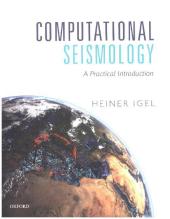 Neuerscheinungen 2016Stand: 2020-02-01 |
Schnellsuche
ISBN/Stichwort/Autor
|
Herderstraße 10
10625 Berlin
Tel.: 030 315 714 16
Fax 030 315 714 14
info@buchspektrum.de |

Heiner Igel
Computational Seismology
A Practical Introduction
2016. 352 S. 152 b/w, 65 colour. 246 mm
Verlag/Jahr: OXFORD UNIVERSITY PRESS 2016
ISBN: 0-19-871741-5 (0198717415)
Neue ISBN: 978-0-19-871741-6 (9780198717416)
Preis und Lieferzeit: Bitte klicken
This book is an introductory text to a range of numerical methods used today to simulate time-dependent processes in Earth science, physics, engineering, and many other fields. It looks under the hood of current simulation technology and provides guidelines on what to look out for when carrying out sophisticated simulation tasks.
This book is an introductory text to a range of numerical methods used today to simulate time-dependent processes in Earth science, physics, engineering, and many other fields. The physical problem of elastic wave propagation in 1D serves as a model system with which the various numerical methods are introduced and compared. The theoretical background is presented with substantial graphical material supporting the concepts. The results can be reproduced with the
supplementary electronic material provided as python codes embedded in Jupyter notebooks. The book starts with a primer on the physics of elastic wave propagation, and a chapter on the fundamentals of parallel programming, computational grids, mesh generation, and hardware models. The core of the book
is the presentation of numerical solutions of the wave equation with six different methods: 1) the finite-difference method; 2) the pseudospectral method (Fourier and Chebyshev); 3) the linear finite-element method; 4) the spectral-element method; 5) the finite-volume method; and 6) the discontinuous Galerkin method. Each chapter contains comprehension questions, theoretical, and programming exercises. The book closes with a discussion of domains of application and criteria for the choice of a
specific numerical method, and the presentation of current challenges.
It is intended to work as an introductory handbook, containing a coherent balance of theory, concepts and applications, as well as a very rich source of references where to look at if the reader wishes deepening their understanding of what was presented... Unquestionably, it is a valuable and essential book that sets the foundations of this century´s computational seismology. Carlos Medel-Vera, Contemporary Physics
Heiner Igel studied geophysics in Karlsruhe and Edinburgh. He obtained his doctoral degree in 1993 from the Institut de Physique du Globe in Paris developing parallel forward and inverse modelling tools for wave propagation problems. He then moved to the Institute of Theoretical Geophysics in Cambridge, UK, where he worked on wave simulation techniques for regional and global seismic wave propagation. In 1999 he became Professor of Seismology at the
Ludwig-Maximilians-University Munich. His current interests include full-waveform inversion, high-performance computing, and rotational ground motions. He is a member of the German National Academy of Sciences.


